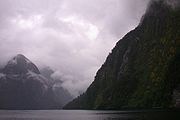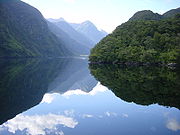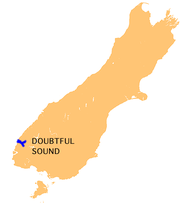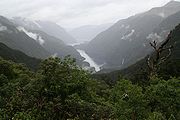
Doubtful Sound
Encyclopedia



Fjord
Geologically, a fjord is a long, narrow inlet with steep sides or cliffs, created in a valley carved by glacial activity.-Formation:A fjord is formed when a glacier cuts a U-shaped valley by abrasion of the surrounding bedrock. Glacial melting is accompanied by rebound of Earth's crust as the ice...
(despite its name) in Fiordland
Fiordland
Fiordland is a geographic region of New Zealand that is situated on the south-western corner of the South Island, comprising the western-most third of Southland. Most of Fiordland is dominated by the steep sides of the snow-capped Southern Alps, deep lakes and its ocean-flooded, steep western valleys...
, in the far south west of New Zealand
New Zealand
New Zealand is an island country in the south-western Pacific Ocean comprising two main landmasses and numerous smaller islands. The country is situated some east of Australia across the Tasman Sea, and roughly south of the Pacific island nations of New Caledonia, Fiji, and Tonga...
. It is located in the same region as the smaller but more famous and accessible Milford Sound
Milford Sound
Milford Sound is a fjord in the south west of New Zealand's South Island, within Fiordland National Park, Piopiotahi Marine Reserve, and the Te Wahipounamu World Heritage site...
. It took second place after said Fiord as New Zealand's most famous tourism destination.
History
Doubtful Sound was named 'Doubtful Harbour' in 1770 by Captain Cook, who did not enter the inlet as he was uncertain whether it was navigable under sail. It was later renamed Doubtful Sound by whalerWhaler
A whaler is a specialized ship, designed for whaling, the catching and/or processing of whales. The former included the whale catcher, a steam or diesel-driven vessel with a harpoon gun mounted at its bows. The latter included such vessels as the sail or steam-driven whaleship of the 16th to early...
s and sealers.
A Spanish scientific expedition commanded by Alessandro Malaspina
Alessandro Malaspina
Alessandro Malaspina was an Italian nobleman who spent most of his life as a Spanish naval officer and explorer...
visited Doubtful Sound in February 1793 to conduct experiments measuring the force of gravity using a pendulum
Pendulum
A pendulum is a weight suspended from a pivot so that it can swing freely. When a pendulum is displaced from its resting equilibrium position, it is subject to a restoring force due to gravity that will accelerate it back toward the equilibrium position...
, a part of the effort to establish a new metric system. The officers of the expedition, which included Felipe Bauzá y Cañas, a cartographer, also made the first chart of the entrance and lower parts of the Sound, naming features of it. Today these form a unique cluster of the only Spanish names on the map of New Zealand: Febrero Point, Bauza Island and the Nee Islets, Pendulo Reach and Malaspina Reach.
Geography

Deep Cove, New Zealand
Deep Cove is an arm of Doubtful Sound, a deep indentation in the southwest coast of New Zealand's South Island. Along with the Hall Arm, which lies to the southwest of Deep Cove, it forms one of the two most remote parts of the sound from the Tasman Sea, with its mouth being from the mouth of...
, and the Browne Falls
Browne Falls
Browne Falls is a waterfall above Doubtful Sound, which is located in Fiordland National Park, New Zealand. In breathtaking scenery amidst temperate rain forest, the falls cascade down to the fiord near Hall Arm...
which have a fall of over 600 metres. The steep hills are known for their hundreds of waterfall
Waterfall
A waterfall is a place where flowing water rapidly drops in elevation as it flows over a steep region or a cliff.-Formation:Waterfalls are commonly formed when a river is young. At these times the channel is often narrow and deep. When the river courses over resistant bedrock, erosion happens...
s during the rainy season.
Access to the sound is either by sea, or by the Wilmot Pass
Wilmot Pass
The Wilmot Pass is a high pass on the main divide of New Zealand's South Island. It connects Doubtful Sound, a deep indentation in the coast of Fiordland, to the valley of the West Arm of Lake Manapouri. The pass is named after E. H. Wilmot, a former surveyor-general of New Zealand, who had noted...
road from the Manapouri Power Station
Manapouri Power Station
Manapouri Power Station is an underground hydroelectric power station on the western arm of Lake Manapouri in Fiordland National Park, in the South Island of New Zealand...
. Most areas of the sound itself are only accessible by sea however, as the road network in this area of New Zealand is sparse or nonexistent, as is the human population.
Charles John Lyttelton, 10th Viscount Cobham
Viscount Cobham
Viscount Cobham is a title in the Peerage of Great Britain. It was created in 1718 for Field Marshal Richard Temple, 1st Baron Cobham and 4th Baronet, of Stowe...
, Governor-General of New Zealand
Governor-General of New Zealand
The Governor-General of New Zealand is the representative of the monarch of New Zealand . The Governor-General acts as the Queen's vice-regal representative in New Zealand and is often viewed as the de facto head of state....
(1957-1962) wrote about this part of Fiordland
Fiordland
Fiordland is a geographic region of New Zealand that is situated on the south-western corner of the South Island, comprising the western-most third of Southland. Most of Fiordland is dominated by the steep sides of the snow-capped Southern Alps, deep lakes and its ocean-flooded, steep western valleys...
:
- "There are just a few areas left in the world where no human has ever set foot. That one of them should be in a country so civilized and so advanced as New Zealand may seem incredible, unless one has visited the south-west corner of the South Island. Jagged razor backed mountains rear their heads into the sky. More than 200 days of rain a year ensure not a tree branch is left bare and brown, moss and epiphytes drape every nook. The forest is intensely green. This is big country... one day peaceful, a study in green and blue, the next melancholy and misty, with low cloud veiling the tops... an awesome place, with its granite precipices, its hanging valleys, its earthquake faults and its thundering cascades."
Parts of the sound on the west side of Elizabeth Island are protected by the Taipari Roa (Elizabeth Island) Marine Reserve
Fiordland's marine reserves
There are ten marine reserves in Fiordland region of New Zealand's South Island. They protect a wide variety of species and habitats. The original two reserves were established at the request of New Zealand Federation of Commercial Fishermen in 1993...
.
Flora and fauna
Doubtful Sound is unusual in that it contains two distinct layers of water that scarcely mix. The top few meters is fresh water, fed from the high inflows from the surrounding mountains, and stained brown with tannins from the forest. Below this is a layer of cold, heavy, salineSalinity
Salinity is the saltiness or dissolved salt content of a body of water. It is a general term used to describe the levels of different salts such as sodium chloride, magnesium and calcium sulfates, and bicarbonates...
water from the sea. The dark tannins in the fresh water layer makes it difficult for light to penetrate. Thus, many deep-sea species will grow in the comparatively shallow depths of the Sound.
This fiord is home to one of the southernmost population of bottlenose dolphin
Bottlenose Dolphin
Bottlenose dolphins, the genus Tursiops, are the most common and well-known members of the family Delphinidae, the family of oceanic dolphins. Recent molecular studies show the genus contains two species, the common bottlenose dolphin and the Indo-Pacific bottlenose dolphin , instead of one...
s. The Doubtful Sound bottlenoses have formed a very insular sub-group of only about 70 individuals, with none having been observed to leave or enter the Sound during a multi-year monitoring regime. Their social grouping is thus extremely close, which is also partly attributed to the difficult and unusual features of their habitat, which is much colder than for other bottlenose groups and is also overlaid by the freshwater layer. Recently (2000s), there is growing concern that the population is in significant decline, with calf survival rates having halved, as well as being noticeably lower than in captivity or in other New Zealand environments. The reasons for this are unclear, though increased tourism or the fresh-water discharge from the Manapouri Power Station (see Hydroelectricity section below) are considered potential causes.
Other wildlife to be found in Doubtful Sound includes fur seal
Fur seal
Fur seals are any of nine species of pinnipeds in the Otariidae family. One species, the northern fur seal inhabits the North Pacific, while seven species in the Arctocephalus genus are found primarily in the Southern hemisphere...
s and penguin
Penguin
Penguins are a group of aquatic, flightless birds living almost exclusively in the southern hemisphere, especially in Antarctica. Highly adapted for life in the water, penguins have countershaded dark and white plumage, and their wings have become flippers...
s (Fiordland crested and blue), or even rare large whale
Whale
Whale is the common name for various marine mammals of the order Cetacea. The term whale sometimes refers to all cetaceans, but more often it excludes dolphins and porpoises, which belong to suborder Odontoceti . This suborder also includes the sperm whale, killer whale, pilot whale, and beluga...
s (Southern Right Whale
Southern Right Whale
The southern right whale is a baleen whale, one of three species classified as right whales belonging to the genus Eubalaena. Like other right whales, the southern right whale is readily distinguished from others by the callosities on its head, a broad back without a dorsal fin, and a long arching...
, Humpback Whale
Humpback Whale
The humpback whale is a species of baleen whale. One of the larger rorqual species, adults range in length from and weigh approximately . The humpback has a distinctive body shape, with unusually long pectoral fins and a knobbly head. It is an acrobatic animal, often breaching and slapping the...
, Minke Whale, Sperm Whale
Sperm Whale
The sperm whale, Physeter macrocephalus, is a marine mammal species, order Cetacea, a toothed whale having the largest brain of any animal. The name comes from the milky-white waxy substance, spermaceti, found in the animal's head. The sperm whale is the only living member of genus Physeter...
and some Giant Beaked Whale
Giant beaked whale
The genus Berardius contains two species of beaked whale, Baird's beaked whale and Arnoux's beaked whale. The two species are so similar, some scientists regard their separation into distinct species as a historical anomaly...
s). Orca, the Killer Whales and Long-Finned Pilot Whale
Long-finned Pilot Whale
The long-finned pilot whale is one of the two species of cetacean in the genus Globicephala. It belongs to the oceanic dolphin family , though its behavior is closer to that of the larger whales.-Description:...
s can be found also. The waters of Doubtful Sound are also home to an abundance of sea creatures, including many species of fish
Fish
Fish are a paraphyletic group of organisms that consist of all gill-bearing aquatic vertebrate animals that lack limbs with digits. Included in this definition are the living hagfish, lampreys, and cartilaginous and bony fish, as well as various extinct related groups...
, starfish, sea anemone
Sea anemone
Sea anemones are a group of water-dwelling, predatory animals of the order Actiniaria; they are named after the anemone, a terrestrial flower. Sea anemones are classified in the phylum Cnidaria, class Anthozoa, subclass Zoantharia. Anthozoa often have large polyps that allow for digestion of larger...
s and coral
Coral
Corals are marine animals in class Anthozoa of phylum Cnidaria typically living in compact colonies of many identical individual "polyps". The group includes the important reef builders that inhabit tropical oceans and secrete calcium carbonate to form a hard skeleton.A coral "head" is a colony of...
s. It is perhaps best known for its black coral
Black coral
Black corals are a group of deep water, tree-like corals related to sea anemones. They are also found in rare dark shallow water areas such as New Zealand's Milford Sound where they can be viewed from an underwater observatory. They normally occur in the tropics...
trees which occur in unusually shallow water for what is normally a deep water species.
The catchment basin of Doubtful Sound is generally steep terrain that is heavily forested except for locations where surface rock exposures are extensive. Nothofagus
Nothofagus
Nothofagus, also known as the southern beeches, is a genus of 35 species of trees and shrubs native to the temperate oceanic to tropical Southern Hemisphere in southern South America and Australasia...
trees are dominant in many locations. In the understory there are a wide variety of shrubs and fern
Fern
A fern is any one of a group of about 12,000 species of plants belonging to the botanical group known as Pteridophyta. Unlike mosses, they have xylem and phloem . They have stems, leaves, and roots like other vascular plants...
s, including Crown Fern, Blechnum discolor
Blechnum discolor
Blechnum discolor is a species of fern in the family Blechnaceae. This species is endemic to New Zealand. As noted by C. Michael Hogan, this species is found in a number of forest communities in diverse locations within New Zealand, and is sometimes a dominant understory component.Spores are...
.
Hydroelectricity

Deep Cove, New Zealand
Deep Cove is an arm of Doubtful Sound, a deep indentation in the southwest coast of New Zealand's South Island. Along with the Hall Arm, which lies to the southwest of Deep Cove, it forms one of the two most remote parts of the sound from the Tasman Sea, with its mouth being from the mouth of...
(45°27′S 167°09′E), an arm of Doubtful Sound, is the site of discharge of water from the Manapouri Power Station's tailrace tunnels. Deep Cove, like the rest of Fiordland is a unique and mostly pristine environment. The discharge of clear fresh water has had an impact on fauna and flora by letting light into the lower layers of the sound. Nevertheless, this is an area naturally high in fresh water inflows (7.6 metres of rain falls annually).

